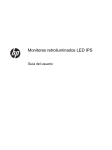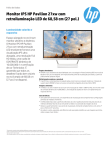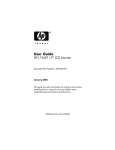Download User Guide - B&H Photo Video Digital Cameras, Photography
Transcript
IPS LED Backlit Monitors User Guide © 2014, Hewlett-Packard Development Company, L.P. Windows is either a trademark or registered trademark of Microsoft Corporation in the United States and/or other countries. The only warranties for HP products and services are set forth in the express warranty statements accompanying such products and services. Nothing herein should be construed as constituting an additional warranty. HP shall not be liable for technical or editorial errors or omissions contained herein. This document contains proprietary information that is protected by copyright. No part of this document may be photocopied, reproduced, or translated to another language without the prior written consent of Hewlett-Packard Company. First Edition: September 2014 Document Part Number: 786794-001 About This Guide This guide provides information on monitor features, setting up the monitor, using the software and technical specifications. WARNING! Text set off in this manner indicates that failure to follow directions could result in bodily harm or loss of life. CAUTION: Text set off in this manner indicates that failure to follow directions could result in damage to equipment or loss of information. NOTE: Text set off in this manner provides important supplemental information. TIP: Text set off in this manner provides helpful hints. This product incorporates HDMI technology. iii iv About This Guide Table of contents 1 Product Features .............................................................................................................................................. 1 HP IPS LCD Backlit Monitors ............................................................................................................... 1 2 Safety and maintenance guidelines .................................................................................................................. 3 Important safety information ................................................................................................................. 3 Maintenance guidelines ........................................................................................................................ 4 Cleaning the monitor ............................................................................................................ 4 Shipping the monitor ............................................................................................................ 4 3 Setting Up the Monitor ...................................................................................................................................... 5 Attaching the Monitor Stand ................................................................................................................. 5 Identifying Rear Components ............................................................................................................... 6 Connecting the Cables ......................................................................................................................... 7 Identifying Front Panel Controls ........................................................................................................... 9 Menu button functions ....................................................................................................... 10 Adjusting the Monitor .......................................................................................................................... 11 Turning on the Monitor ....................................................................................................................... 12 HP Watermark and Image Retention Policy ....................................................................................... 12 Mounting the Monitor (Optional) ......................................................................................................... 13 Removing the Monitor Stand ............................................................................................. 13 Attaching the VESA Mount Kit (Available with Select Models) .......................................... 14 Locating the Rating Label ................................................................................................................... 15 Installing a Cable Lock ....................................................................................................................... 15 4 Operating the monitor ..................................................................................................................................... 16 Software and utilities .......................................................................................................................... 16 The Information file ............................................................................................................ 16 The Image Color Matching file ........................................................................................... 16 Installing the .INF and .ICM files ........................................................................................................ 16 Installing from the disc ....................................................................................................... 16 Downloading from the Web ............................................................................................... 17 v Using My Display software ................................................................................................................. 18 Installing the software ........................................................................................................ 18 Using the software ............................................................................................................. 18 Downloading the software ................................................................................................. 18 Using Auto-Sleep Mode ..................................................................................................................... 19 Using the On-Screen Display (OSD) menu ........................................................................................ 20 Appendix A Technical Specifications ................................................................................................................. 21 22cw/22xw Models ............................................................................................................................. 21 23cw/23xw Models ............................................................................................................................. 22 25cw/25xw Models ............................................................................................................................. 23 27cw/27xw Models ............................................................................................................................. 24 Recognizing Preset Display Resolutions ............................................................................................ 26 Factory Preset Modes ........................................................................................................ 26 High-definition Video Formats ........................................................................................... 26 Power Adapters ................................................................................................................. 26 Entering User Modes .......................................................................................................................... 27 Appendix B Support and troubleshooting .......................................................................................................... 28 Solving common problems ................................................................................................................. 28 Using the Auto-Adjustment Function (Analog Input) .......................................................................... 29 Optimizing Image Performance (Analog Input) .................................................................................. 30 Button lockouts ................................................................................................................................... 31 Product support .................................................................................................................................. 31 Preparing to call technical support ..................................................................................................... 31 vi 1 Product Features HP IPS LCD Backlit Monitors NOTE: Some models described in this guide may not be available in your country or region. The LCD (liquid crystal display) monitors have an active matrix, In-Plane Switching (IPS) panel. The monitor models and features include: ● 22cw/22xw models, 54.6 cm (21.5-in) diagonal viewable area display with 1920 x 1080 resolution, plus full-screen support for lower resolutions; includes custom scaling for maximum image size while preserving original aspect ratio ● 23cw/23xw models, 58.4 cm (23-in) diagonal viewable area display with 1920 x 1080 resolution, plus full-screen support for lower resolutions; includes custom scaling for maximum image size while preserving original aspect ratio ● 25cw/25xw models, 63.3 cm (25-in) diagonal viewable area display with 1920 x 1080 resolution, plus full-screen support for lower resolutions; includes custom scaling for maximum image size while preserving original aspect ratio ● 27cw/27xw models, 68.6cm (27-in) diagonal viewable area display with 1920 x 1080 resolution, plus full-screen support for lower resolutions; includes custom scaling for maximum image size while preserving original aspect ratio ● LED backlight that consumes less energy ● Tilt capability and wide viewing angle to allow viewing from a sitting or standing position, or moving from side to side ● Video signal input to support VGA analog ● Video signal input to support high-definition multimedia interface (HDMI) ● Plug and play capability if supported by your operating system ● Security slot provision on rear of monitor for optional cable lock ● On-Screen Display (OSD) adjustments in several languages for easy setup and screen optimization ● My Display software for adjusting monitor settings ● HDCP (High-bandwidth Digital Content Protection) copy protection on HDMI inputs ● Software and documentation disc that includes monitor drivers and product documentation ● Energy saver feature to meet requirements for reduced power consumption HP IPS LCD Backlit Monitors 1 NOTE: For safety and regulatory information, refer to the Product Notices provided on your media disc, if one is included, or in your documentation kit. To locate updates to the user guide for your product, go to http://www.hp.com/support, and select your country. Select Drivers & Downloads, and then follow the on-screen instructions. 2 Chapter 1 Product Features 2 Safety and maintenance guidelines Important safety information A power cord is included with the monitor. If another cord is used, use only a power source and connection appropriate for this monitor. For information on the correct power cord set to use with the monitor, refer to the Product Notices provided on your media disc, if one is included, or in your documentation kit. WARNING! To reduce the risk of electric shock or damage to the equipment: • Plug the power cord into an AC outlet that is easily accessible at all times. • Disconnect power from the computer by unplugging the power cord from the AC outlet. • If provided with a 3-pin attachment plug on the power cord, plug the cord into a grounded (earthed) 3-pin outlet. Do not disable the power cord grounding pin, for example, by attaching a 2-pin adapter. The grounding pin is an important safety feature. For your safety, do not place anything on power cords or cables. Arrange them so that no one may accidentally step on or trip over them. Do not pull on a cord or cable. When unplugging from the electrical outlet, grasp the cord by the plug. To reduce the risk of serious injury, read the Safety and Comfort Guide. It describes proper workstation, setup, posture, and health and work habits for computer users, and provides important electrical and mechanical safety information. This guide is located on the Web at http://www.hp.com/ ergo. CAUTION: For the protection of the monitor, as well as the computer, connect all power cords for the computer and its peripheral devices (such as a monitor, printer, scanner) to some form of surge protection device such as a power strip or Uninterruptible Power Supply (UPS). Not all power strips provide surge protection; the power strips must be specifically labeled as having this ability. Use a power strip whose manufacturer offers a Damage Replacement Policy so you can replace the equipment, if surge protection fails. Use the appropriate and correctly sized furniture designed to properly support your HP LCD monitor. WARNING! LCD monitors that are inappropriately situated on dressers, bookcases, shelves, desks, speakers, chests, or carts may fall over and cause personal injury. Care should be taken to route all cords and cables connected to the LCD monitor so that they cannot be pulled, grabbed, or tripped over. NOTE: This product is suitable for entertainment purposes. Consider placing the display in a controlled luminous environment to avoid interference from surrounding light and bright surfaces that may cause disturbing reflections from the screen. Important safety information 3 Maintenance guidelines To enhance the performance and extend the life of the monitor: ● Do not open the monitor cabinet or attempt to service this product yourself. Adjust only those controls that are covered in the operating instructions. If the monitor is not operating properly or has been dropped or damaged, contact an authorized HP dealer, reseller, or service provider. ● Use only a power source and connection appropriate for this monitor, as indicated on the label/ back plate of the monitor. ● Be sure the total ampere rating of the products connected to the outlet does not exceed the current rating of the electrical outlet, and the total ampere rating of the products connected to the cord does not exceed the rating of the cord. Look on the power label to determine the ampere rating (AMPS or A) for each device. ● Install the monitor near an outlet that you can easily reach. Disconnect the monitor by grasping the plug firmly and pulling it from the outlet. Never disconnect the monitor by pulling the cord. ● Turn the monitor off when not in use. You can substantially increase the life expectancy of the monitor by using a screen saver program and turning off the monitor when not in use. NOTE: Monitors with a “burned-in image” are not covered under the HP warranty. ● Slots and openings in the cabinet are provided for ventilation. These openings must not be blocked or covered. Never push objects of any kind into cabinet slots or other openings. ● Do not drop the monitor or place it on an unstable surface. ● Do not allow anything to rest on the power cord. Do not walk on the cord. ● Keep the monitor in a well-ventilated area, away from excessive light, heat or moisture. ● When removing the monitor stand, you must lay the monitor face down on a soft area to prevent it from getting scratched, defaced, or broken. Cleaning the monitor 1. Turn off the monitor and unplug the power cord from the back of the unit. 2. Dust the monitor by wiping the screen and the cabinet with a soft, clean antistatic cloth. 3. For more difficult cleaning situations, use a 50/50 mix of water and Isopropyl alcohol. CAUTION: Spray the cleaner onto a cloth and use the damp cloth to gently wipe the screen surface. Never spray the cleaner directly on the screen surface. It may run behind the bezel and damage the electronics. CAUTION: Do not use cleaners that contain any petroleum based materials such as benzene, thinner, or any volatile substance to clean the monitor screen or cabinet. These chemicals may damage the monitor. Shipping the monitor Keep the original packing box in a storage area. You may need it later if you move or ship the monitor. 4 Chapter 2 Safety and maintenance guidelines 3 Setting Up the Monitor To set up the monitor, ensure that the power is turned off to the monitor, computer system, and other attached devices, then follow the instructions below. Attaching the Monitor Stand CAUTION: The screen is fragile. Avoid touching or applying pressure to the screen; doing so can cause damage. TIP: Consider the placement of the display, because the bezel might cause interfering reflections from surrounding light and bright surfaces. 1. Remove the stand/base assembly, and then lift the monitor from the box and place it face down on a flat surface. 2. Slide the stand into the base until the stand is locked in place. Attaching the Monitor Stand 5 3. Insert the two tabs on the stand into the slot on the back of the display head until they click into place. Identifying Rear Components Component Function 1 VGA Connects the VGA cable from the computer to the monitor 2 HDMI Connects the HDMI cable from the computer to the monitor 3 HDMI* Connects the HDMI cable from the computer to the monitor 4 DC Power LED Illuminates when power adapter is connected to the monitor 5 DC Power Connector Connects the DC power adapter to the monitor 6 Cable Lock Slot Connects the optional cable lock to the monitor * Select models only 6 Chapter 3 Setting Up the Monitor Connecting the Cables 1. Place the monitor in a convenient, well-ventilated location near the computer. 2. Connect a signal cable. NOTE: The monitor is capable of supporting analog or HDMI input. The video mode is determined by the video cable used. The monitor will automatically determine which inputs have valid video signals. The inputs can be selected by pressing the Source button on the front panel or through the On-Screen Display (OSD) feature by pressing the Menu button. ● For analog operation, use a VGA signal cable. Connect the VGA signal cable to the VGA connector on the rear of the monitor and the other end to the VGA connector on the computer. ● Connect an HDMI cable to an HDMI port on the rear of the monitor and the other end to the HDMI port on the source device. The HDMI cable is included for select models only. Connecting the Cables 7 3. Connect one end of the power cord to the power supply (1) and the other end to a grounded electrical outlet (2), and then connect the round end of the power supply cord to the monitor (3). WARNING! To reduce the risk of electric shock or damage to the equipment: Do not disable the power cord grounding plug. The grounding plug is an important safety feature. Plug the power cord into a grounded (earthed) electrical outlet that is easily accessible at all times. Disconnect power from the equipment by unplugging the power cord from the electrical outlet. For your safety, do not place anything on power cords or cables. Arrange them so that no one may accidentally step on or trip over them. Do not pull on a cord or cable. When unplugging from the electrical outlet, grasp the cord by the plug. 8 Chapter 3 Setting Up the Monitor Identifying Front Panel Controls Control Function 1 Menu Opens, selects or exits the OSD menu. 2 Brightness Brightness If the OSD menu is inactive, press to activate the Brightness Menu to adjust brightness. – (Minus) QuickView – If the OSD menu is on, press to navigate backward through the OSD menu and decrease adjustment levels. QuickView If the OSD menu is inactive, press to activate the QuickView button that chooses different settings (HP Enhance+, Movie, Photo, Gaming, Text, Custom). 3 Auto Adjustment QuickView + (Plus) Auto Adjustment Press and hold to automatically adjust the screen image. NOTE: This item can only be used with a VGA input signal. QuickView If the OSD menu is inactive, press to activate the Quick View button that chooses different settings (HP Enhance+, Movie, Photo, Gaming, Text, Custom). + If the OSD menu is on, press to navigate forward through the OSD menu and increase adjustment levels. 4 Source Back/Cancel/Exit 5 Power Source If the OSD menu is inactive, press to activate the Source button that chooses the video signal input (VGA or HDMI). Back/Cancel/Exit Press to go back, cancel, or exit. Turns the monitor on or off. NOTE: To view an OSD menu simulator, visit the HP Customer Self Repair Services Media Library at http://www.hp.com/go/sml. Identifying Front Panel Controls 9 Menu button functions Pressing one of the four Menu buttons on the bottom of the monitor activates the buttons and displays the icons next to the buttons. The function of the buttons depends on the active video input and the model. If the active video input is an analog signal (VGA input), the buttons have the following functions. Button Function 1 Menu Opens the OSD (On-Screen Display) main menu, selects a menu item from the OSD, or closes the OSD menu. 2 Quick View Opens the Quick View menu where you can select a color setting for your application. 3 Auto-Adjust Activates the auto-adjustment feature to optimize the screen. 4 Next Active Input Switches the monitor's input source to the next active input. If the active video input is a digital signal (HDMI input), the buttons have the following functions. 10 Button Function 1 Menu Opens the OSD (On-Screen Display) main menu, select a menu item from the OSD, or closes the OSD menu. 2 Brightness Opens the Brightness adjustment scale. 3 Quick View Opens the Quick View menu where you can select a color setting for your application. 4 Next Active Input Switches the monitor's input source to the next active input. Chapter 3 Setting Up the Monitor Adjusting the Monitor Tilt the monitor panel forward or backward to set it to a comfortable eye level. Adjusting the Monitor 11 Turning on the Monitor 1. Press the power button on the front of the monitor to turn it on. 2. Press the power button on the computer to turn it on. CAUTION: Burn-in image damage may occur on monitors that display the same static image on screen for a prolonged period of time.* To avoid burn-in image damage on the monitor screen, you should always activate a screen saver application or turn off the monitor when it is not in use for a prolonged period of time. Image retention is a condition that may occur on all LCD screens. Monitors with a “burned-in image” are not covered under the HP warranty. * A prolonged period of time is 12 consecutive hours of non-use. NOTE: If pressing the power button has no effect, the Power Button Lockout feature may be enabled. To disable this feature, press and hold the monitor power button for 10 seconds. NOTE: You can disable the power LED in the OSD menu. Press the Menu button on the front of the monitor, then select Management > Bezel Power LED > Off. When the monitor is powered on, a Monitor Status message is displayed for five seconds. The message shows which input (VGA or HDMI) is the current active signal, the status of the auto-switch source setting (On or Off; factory default is On), the default source signal (factory default is Autoswitch), the current preset display resolution, and the recommended preset display resolution. The monitor automatically scans the signal inputs for an active input and uses that input for the display. If two or more inputs are active, the monitor will display the default input source. If the default source is not one of the active inputs, then the monitor will display the highest ranking priority input in the following order: HDMI, then VGA. You can change the default source in the OSD by pressing the front panel Source button. HP Watermark and Image Retention Policy The IPS monitor models are designed with IPS (In-Plane Switching) display technology which provides ultra-wide viewing angles and advanced image quality. IPS monitors are suitable for a wide variety of advanced image quality applications. This panel technology, however, is not suitable for applications that exhibit static, stationary or fixed images for long periods of time without the use of screen savers. These types of applications may include camera surveillance, video games, marketing logos, and templates that are displayed on the screen for a prolonged period of time. Static images may cause image retention damage that could look like stains or watermarks on the monitor's screen. Monitors in use for 24 hours per day that result in image retention damage are not covered under the HP warranty. To avoid image retention damage, always turn off the monitor when it is not in use or use the power management setting, if supported on your system, to turn off the display when the system is idle. 12 Chapter 3 Setting Up the Monitor Mounting the Monitor (Optional) The monitor panel can be attached to a VESA mount kit provided with select models. To attach the VESA mount kit, use the following steps. NOTE: This apparatus is intended to be supported by UL or CSA Listed wall mount bracket. CAUTION: This VESA mount kit supports the VESA industry standard 100 mm mounting holes. To attach a third-party mounting solution to the VESA mount, four 4 mm, 0.7 pitch, and 10 mm long screws are required. Longer screws must not be used because they may damage the monitor. It is important to verify that the manufacturer’s mounting solution is compliant with the VESA standard and is rated to support the weight of the monitor display panel. For best performance, it is important to use the power and video cables provided with the monitor. Removing the Monitor Stand You can remove the monitor panel from the stand to install the panel on a wall, a swing arm, or other mounting fixture. CAUTION: Before beginning to disassemble the monitor, be sure the monitor is turned off and all cables are disconnected. 1. Disconnect and remove all cables from the monitor. 2. Adjust the monitor to the vertical position. 3. Lay the monitor face down on a flat surface covered by a clean, dry cloth. 4. Press down on the release latch (1) and slide the stand out of the slot on the display head (2). Mounting the Monitor (Optional) 13 Attaching the VESA Mount Kit (Available with Select Models) 14 1. Remove the monitor stand. Refer to Removing the Monitor Stand on page 13. 2. Remove the screw from the center of the rear of the display head. 3. Insert the tab at the bottom of the VESA mount into the slot on the back of the display head until the VESA mount clicks in place (1), and then secure the top of the VESA mount with the screw that was installed in the center of the display head (2). 4. To attach the monitor to a swing arm or other mounting device (purchased separately), insert four mounting screws through the holes on the mounting device and into the screw holes on the VESA mount that was installed on the rear of the monitor. Chapter 3 Setting Up the Monitor Locating the Rating Label The rating label on the monitor provides the product number and serial number. You may need these numbers when contacting HP about the monitor model. The rating label is located on the bottom of the monitor. Installing a Cable Lock You can secure the monitor to a fixed object with an optional cable lock available from HP. Locating the Rating Label 15 4 Operating the monitor Software and utilities The disc that comes with the monitor contains files you can install on the computer: ● an .INF (Information) file ● ICM (Image Color Matching) files (one for each calibrated color space) ● My Display software The Information file The .INF file defines monitor resources used by Microsoft Windows operating systems to ensure monitor compatibility with the computer’s graphics adapter. This monitor is Microsoft Windows Plug and Play compatible and the monitor will work correctly without installing the .INF file. Monitor Plug and Play compatibility requires that the computer’s graphic card is VESA DDC2–compliant and that the monitor connects directly to the graphics card. Plug and Play does not work through separate BNC type connectors or through distribution buffers/ boxes. The Image Color Matching file The .ICM files are data files that are used in conjunction with graphics programs to provide consistent color matching from monitor screen to printer, or from scanner to monitor screen. This file is activated from within graphics programs that support this feature. NOTE: The ICM color profile is written in accordance with the International Color Consortium (ICC) Profile Format specification. Installing the .INF and .ICM files After you determine that you need to update, you can install the .INF and .ICM files from the disc or download them. Installing from the disc To install the .INF and .ICM files on the computer from the disc: 16 1. Insert the disc in the computer optical drive. The disc menu is displayed. 2. View the HP Monitor Software Information file. Chapter 4 Operating the monitor 3. Select Install Monitor Driver Software. 4. Follow the on-screen instructions. 5. Ensure that the proper resolution and refresh rates appear in the Windows Display control panel. NOTE: You may need to install the digitally signed monitor .INF and .ICM files manually from the disc in the event of an installation error. Refer to the HP Monitor Software Information file on the disc. Downloading from the Web To download the latest version of .INF and .ICM files from the HP monitors support Web site: 1. Go to http://www.hp.com/support and select the appropriate country and language. 2. Select Drivers & Downloads, type your monitor model in the Find by product search field, and click Go. 3. If necessary, select your monitor from the list. 4. Select your operating system, and then click Next. 5. Click Driver - Display/Monitor to open the list of drivers. 6. Click on the driver. 7. Click the System Requirements tab, and then verify that your system meets the program minimum requirements. 8. Click Download and follow the on-screen instructions to download the software. Installing the .INF and .ICM files 17 Using My Display software The disc provided with the monitor includes My Display software. Use My Display software to choose preferences for optimum viewing. You can select settings for gaming, movies, photo editing or just working on documents and spreadsheets. You can also easily adjust settings such as brightness, color, and contrast using My Display software. Installing the software To install the software: 1. Insert the disc in your computer disc drive. The disc menu is displayed. 2. Select the language. NOTE: This choice selects the language you will see while installing the software. The language of the software itself will be determined by the operating system language. 3. Click Install My Display Software. 4. Follow the on-screen instructions. 5. Restart the computer. Using the software To open the My Display software: 1. Click the HP My Display icon on the taskbar. Or Click Windows Start ™ on the taskbar. 2. Click All Programs. 3. Click HP My Display. 4. Select HP My Display. For additional information, refer to the on-screen Help within the software. Downloading the software If you prefer to download the My Display software, follow the instructions below. 18 1. Go to http://www.hp.com/support and select the appropriate country and language. 2. Select Drivers & Downloads, type your monitor model in the Find by product search field, and click Go. 3. If necessary, select your monitor from the list. 4. Select your operating system, and then click Next. 5. Click Utility - Tools to open the list of utilities and tools. 6. Click HP My Display. Chapter 4 Operating the monitor 7. Click the System Requirements tab, and then verify that your system meets the program minimum requirements. 8. Click Download and follow the on-screen instructions to download My Display. Using Auto-Sleep Mode The display supports an OSD (On-Screen Display) option called Auto-Sleep Mode that allows you to enable or disable a reduced power state for the display. When Auto-Sleep Mode is enabled (enabled by default), the monitor will enter a reduced power state when the host PC signals low power mode (absence of either horizontal or vertical sync signal). Upon entering this reduced power state sleep mode, the monitor screen is blanked, the backlight is turned off and the power LED indicator turns amber. The monitor draws less than 0.5W of power when in this reduced power mode. The monitor will wake from the sleep mode when the host PC sends an active signal to the monitor (for example, if you activate the mouse or keyboard). You can disable the Auto-Sleep Mode in the OSD. Press the Menu button on the side panel to open the OSD. In the OSD select Power Control > Auto-Sleep Mode > Off. Using Auto-Sleep Mode 19 Using the On-Screen Display (OSD) menu Use the On-Screen Display (OSD) to adjust the screen image based on your viewing preferences. You can access and make adjustments in the OSD using the buttons on the right side of the display or the buttons on the remote control. To access the OSD and make adjustments, do the following: 1. If the monitor is not already on, press the Power button to turn on the monitor. 2. To access the OSD menu, press the Menu button on the right side of the monitor or on the remote control. 3. To navigate through the OSD menu, press the + (Plus) button on the monitor’s side panel or on the remote control to scroll up, or the – (Minus) button to scroll down. 4. To select an item from the OSD menu, use the + or – buttons to scroll to and highlight your selection, then press the Menu button to select that function. 5. Adjust the item using the + or – buttons to adjust the scale. 6. After adjusting the function, select Save and Return, or Cancel if you don’t want to save the setting, then select Exit from the Main menu. Main Menu Description Brightness Adjusts the brightness level of the screen. The factory default range is 90. Contrast Adjusts the contrast level of the screen. The factory default range is 80. Input Control Selects the video input signal. Color Control Selects and adjusts the screen color. Image Control Adjusts the screen image. Power Control Adjusts the power settings. OSD Control Adjusts the on-screen display (OSD) controls. Management Adjusts the audio settings and returns all OSD menu settings to the factory default settings. Language Selects the language in which the OSD menu is displayed. The factory default is English. Information Selects and displays important information about the monitor. Exit Exits the OSD menu screen. NOTE: Connect to the HP support Website, http://www.hp.com/support to check for updates to software or documentation that might have become available between the manufacturing and delivery of your product. 20 Chapter 4 Operating the monitor A Technical Specifications NOTE: All specifications represent the typical specifications provided by HP's component manufacturers; actual performance may vary either higher or lower. NOTE: Some models described in this guide may not be available in your country or region. 22cw/22xw Models Display 54.6-cm wide screen 21.5-in wide screen Type IPS Viewable Image Size 54.6 cm diagonal Tilt -2° to 25° Maximum Weight (Unpacked) 3.54 kg 7.8 lbs Height 38.5 cm 15.2 in Depth 15.1 cm 5.9 in Width 49.9 cm 19.7 in Maximum Graphic Resolution 1920 x 1080 (60 Hz) analog input 21.5 in diagonal Dimensions (include base) 1920 x 1080 (60 Hz) digital input Optimum Graphic Resolution 1920 x 1080 (60 Hz) analog input 1920 x 1080 (60 Hz) digital input Text Mode 720 × 400 Dot Pitch 0.2480 (H) × 0.2480 (V) mm Pixels Per in 102 PPI Horizontal Frequency 30 to 80 kHz Vertical Refresh Rate 50 to 60 Hz Environmental Requirements Temperature Operating Temperature 5° to 35° C 41° to 95° F Storage Temperature -20° to 60° C -4° to 140° F 22cw/22xw Models 21 Relative Humidity 20 to 70% Power Source 100–240 VAC 50/60 Hz Altitude: Operating 0 to 5000 m 0 to 16,400 ft Storage 0 to 12192 m 0 to 40,000 ft Measured Power Consumption: Full Power 24 W Typical Settings 23 W Sleep <0.5 W Power Off <0.5 W Input Terminal One VGA connector; one HDMI connector 23cw/23xw Models Display 58.4-cm wide screen 23-in wide screen Type IPS Viewable Image Size 58.4 cm diagonal Tilt -2° to 25° Maximum Weight (Unpacked) 3.97 kg 8.8 lbs Height 40.4 cm 15.95 in Depth 15.1 cm 5.9 in Width 53.23 cm 20.96 in Maximum Graphic Resolution 1920 x 1080 (60 Hz) analog input 23 in diagonal Dimensions (include base) 1920 x 1080 (60 Hz) digital input Optimum Graphic Resolution 1920 x 1080 (60 Hz) analog input 1920 x 1080 (60 Hz) digital input 22 Text Mode 720 x 400 Dot Pitch 0.265 (H) x 0.265 (V) mm Pixels Per in 96 PPI Horizontal Frequency 30 to 80 kHz Vertical Refresh Rate 50 to 60 Hz Appendix A Technical Specifications Environmental Requirements Temperature Operating Temperature 5° to 35° C 41° to 95° F Storage Temperature -20° to 60° C -4° to 140° F Relative Humidity 20 to 70% Power Source 100–240 VAC 50/60 Hz Altitude: Operating 0 to 5000 m 0 to 16,400 ft Storage 0 to 12192 m 0 to 40,000 ft Measured Power Consumption: Full Power 27 W Typical Settings 25 W Sleep <0.5 W Power Off <0.5 W Input Terminal One VGA connector; two HDMI connectors 25cw/25xw Models Display 63.3-cm wide screen 25-in wide screen Type IPS Viewable Image Size 63.3 cm diagonal Tilt -2° to 25° Maximum Weight (Unpacked) 5.11 kg 11.2 lbs Height 42.94 cm 16.91 in Depth 16.4 cm 6.5 in Width 57.77 cm 22.74 in Maximum Graphic Resolution 1920 x 1080 (60 Hz) analog input 25 in diagonal Dimensions (include base) 1920 x 1080 (60 Hz) digital input Optimum Graphic Resolution 1920 x 1080 (60 Hz) analog input 1920 x 1080 (60 Hz) digital input Text Mode 720 × 400 Dot Pitch 0.288 (H) x 0.288 (V) mm Pixels Per in 88 PPI 25cw/25xw Models 23 Horizontal Frequency 30 to 80 kHz Vertical Refresh Rate 50 to 60 Hz Environmental Requirements Temperature Operating Temperature 5° to 35° C 41° to 95° F Storage Temperature -20° to 60° C -4° to 140° F Relative Humidity 20 to 70% Power Source 100–240 VAC 50/60 Hz Altitude: Operating 0 to 5000 m 0 to 16,400 ft Storage 0 to 12192 m 0 to 40,000 ft Measured Power Consumption: Full Power 30 W Typical Settings 28 W Sleep <0.5 W Power Off <0.5 W Input Terminal One VGA connector; two HDMI connectors 27cw/27xw Models Display 68.6-cm wide screen 27-in wide screen Type IPS Viewable Image Size 68.6 cm diagonal Tilt -2° to 25° Maximum Weight (Unpacked) 5.5 kg 11.5 lbs Height 45.46 cm 17.9 in Depth 16.4 cm 6.5 in Width 62.26 cm 24.51 in Maximum Graphic Resolution 1920 x 1080 (60 Hz) analog input 27 in diagonal Dimensions (include base) 1920 x 1080 (60 Hz) digital input Optimum Graphic Resolution 1920 x 1080 (60 Hz) analog input 1920 x 1080 (60 Hz) digital input Text Mode 24 Appendix A Technical Specifications 720 × 400 Dot Pitch 0.311 (H) x 0.311 (V) mm Pixels Per in 82 PPI Horizontal Frequency 30 to 80 kHz Vertical Refresh Rate 50 to 60 Hz Environmental Requirements Temperature Operating Temperature 5° to 35° C 41° to 95° F Storage Temperature -20° to 60° C -4° to 140° F Relative Humidity 20 to 70% Power Source 100–240 VAC 50/60 Hz Altitude: Operating 0 to 5000 m 0 to 16,400 ft Storage 0 to 12192 m 0 to 40,000 ft Measured Power Consumption: Full Power 32 W Typical Settings 31 W Sleep <0.5 W Power Off <0.5 W Input Terminal One VGA connector; two HDMI connectors 27cw/27xw Models 25 Recognizing Preset Display Resolutions The display resolutions listed below are the most commonly used modes and are set as factory defaults. This monitor automatically recognizes these preset modes and they will appear properly sized and centered on the screen. NOTE: Some models described in this guide may not be available in your country or region. Factory Preset Modes Preset Pixel Format Horz Freq (kHz) Vert Freq (Hz) 1 640 x 480 31.469 59.94 2 720 x 400 31.469 70.087 3 800 × 600 37.879 60.317 4 1024 × 768 48.363 60.004 5 1280 × 720 45 60 6 1280 × 1024 63.981 60.02 7 1440 × 900 55.935 59.887 8 1600 × 900 60 60 9 1680 × 1050 65.29 59.954 10 1920 × 1080 67.5 60 High-definition Video Formats Preset Timing Name Pixel Format Horz Freq (kHz) Vert Freq (Hz) 1 480p 720 × 480 31.469 60 2 576p 720 × 576 31.25 50 3 720p50 1280 × 720 37.5 50 4 720p60 1280 × 720 45 60 5 1920p60 1920 x 1080 67.5 60 6 1920p50 1920 x 1080 56.25 50 Power Adapters 26 Manufacturer Model Number Power Supply Rating TPV Electronics (Fujian) Co., Ltd. ADPC1945 19Vdc / 2.37A Appendix A Technical Specifications Entering User Modes The video controller signal may occasionally call for a mode that is not preset if: ● You are not using a standard graphics adapter. ● You are not using a preset mode. It this occurs, you may need to readjust the parameters of the monitor screen by using the on-screen display. Your changes can be made to any or all of these modes and saved in memory. The monitor automatically stores the new setting, then recognizes the new mode just as it does a preset mode. In addition to the factory preset modes, there are at least 10 user modes that can be entered and stored. Entering User Modes 27 B Support and troubleshooting Solving common problems The following table lists possible problems, the possible cause of each problem, and the recommended solutions. Problem Possible Cause Solution Screen is blank or video is flashing. Power cord is disconnected. Connect the power cord. Power button is turned off. Press the front panel power button. NOTE: If pressing the power button has no effect, press and hold the power button for 10 seconds to disable the power button lockout feature. 28 Video cable is improperly connected. Connect the video cable properly. Refer to Identifying Front Panel Controls on page 9 for more information. System is in sleep mode. Press any key on the keyboard or move the mouse to inactivate the screen blanking utility. Video card compatibility. Open the OSD menu and select the Input Control menu. Set Auto-Switch Input to Off and manually select the input. Image appears blurred, indistinct, or too dark. Brightness is too low. Open the OSD menu and select Brightness to adjust the brightness scale as needed. Check Video Cable is displayed on screen. Monitor video cable is disconnected. Connect the appropriate video signal cable between the computer and monitor. Be sure that the computer power is off while connecting the video cable. Input Signal Out of Range is displayed on screen. Video resolution and/or refresh rate are set higher than what the monitor supports. Change the settings to a supported setting (see Recognizing Preset Display Resolutions on page 26). The monitor is off but it did not seem to enter into a low-power sleep mode. The monitor's power saving control is disabled. Open the OSD menu and select Power Control > AutoSleep Mode and set auto-sleep to On. OSD Lockout is displayed. The monitor's OSD Lockout function is enabled. Press and hold the Menu button on the side panel for 10 seconds to disable the OSD Lockout function. Power Button Lockout is displayed. The monitor's Power Button Lockout function is enabled. Press and hold the power button for 10 seconds to unlock the power button function. Appendix B Support and troubleshooting Using the Auto-Adjustment Function (Analog Input) When first setting up the monitor, when conducting a Factory Reset of the computer, or whenever you change the resolution of the monitor, the Auto-Adjustment feature will automatically engage, and attempt to optimize your screen for you. You may also optimize the screen performance for the VGA (analog) input at any time by using the Auto button on the monitor (see your model's user guide for the specific button name) and the autoadjustment pattern software utility on the disc provided (select models only). Do not use this procedure if the monitor is using an input other than VGA. If the monitor is using a VGA (analog) input, this procedure can correct the following image quality conditions: ● Fuzzy or unclear focus ● Ghosting, streaking or shadowing effects ● Faint vertical bars ● Thin, horizontal scrolling lines ● An off-center picture To use the auto-adjustment feature: 1. Allow the monitor to warm up for 20 minutes before adjusting. 2. Press the Auto button on the monitor front panel. ● You can also press the Menu button, then select Image Control > Auto-Adjustment from the OSD Main Menu. ● If the result is not satisfactory, continue with the procedure. 3. Insert the disc in the disc drive. The disc menu is displayed. 4. Select Open Auto-Adjustment Software. The setup test pattern is displayed. 5. Press the Auto button on the monitor front panel to produce a stable, centered image. 6. Press the ESC key or any other key on the keyboard to exit the test pattern. NOTE: The auto-adjustment test pattern utility can be downloaded from http://www.hp.com/support. Using the Auto-Adjustment Function (Analog Input) 29 Optimizing Image Performance (Analog Input) Two controls in the on-screen display can be adjusted to improve image performance: Clock and Phase (available in the main menu). NOTE: The Clock and Phase controls are adjustable only when using an analog (VGA) input. These controls are not adjustable for digital inputs. The Clock must first be set correctly since the Phase settings are dependent on the main Clock setting. Use these controls only when the auto-adjustment function does not provide a satisfactory image. ● Clock—Increases/decreases the value to minimize any vertical bars or stripes visible on the screen background. ● Phase—Increases/decreases the value to minimize video flickering or blurring. NOTE: When using the controls, you will obtain the best results by using the auto-adjustment pattern software utility provided on the disc. When adjusting the Clock and Phase values, if the monitor images become distorted, continue adjusting the values until the distortion disappears. To restore the factory settings, select Yes from the Factory Reset menu in the on-screen display. To eliminate vertical bars (Clock): 1. Press the Menu button on the monitor's front panel to open the OSD Menu, and then select Image Control > Clock. 2. Press the + (Plus) or – (Minus) buttons on the monitor's front panel to eliminate vertical bars. Press the buttons slowly so that you do not miss the optimum adjustment point. 3. After adjusting the Clock, if blurring, flickering, or bars appear on the screen, proceed to adjust the Phase. To remove flickering or blurring (Phase): 1. Press the Menu button on the monitor's front panel to open the OSD Menu, and then select Image Control > Phase. 2. Press the + (Plus) or – (Minus) buttons on the monitor's front panel to eliminate flickering or blurring. Flicking or blurring may not be eliminated depending on your computer or graphics controller card installed. To correct screen position (Horizontal Position or Vertical Position): 30 Appendix B Support and troubleshooting 1. Press the Menu button on the monitor's front panel to open the OSD Menu, and then select Image Control > Horizontal Position and/or Vertical Position. 2. Press the + (Plus) or – (Minus) buttons on the monitor's front panel to properly adjust the position of the image in the display area of the monitor. The Horizontal Position shifts the image left or right; the Vertical Position shifts the image up and down. Button lockouts Holding down the power button or Menu button for ten seconds will lock out the functionality of the buttons. You can restore the functionality by holding the buttons down again for ten seconds. This functionality is only available when the display is powered on, displaying an active signal, and the OSD is not active. Product support For additional information on using your monitor, go to http://www.hp.com/support. Select your country or region, select Troubleshooting, and then enter your model in the search window and click the Go button. NOTE: The monitor user guide, reference material, and drivers are available at http://www.hp.com/ support. If the information provided in the guide does not address your questions, you can contact support. For U.S. support, go to http://www.hp.com/go/contactHP. For worldwide support, go to http://welcome.hp.com/country/us/en/wwcontact_us.html. Here you can: ● Chat online with an HP technician NOTE: When support chat is not available in a particular language, it is available in English. ● Find support telephone numbers ● Locate an HP service center Preparing to call technical support If you cannot solve a problem using the troubleshooting tips in this section, you may need to call technical support. Have the following information available when you call: ● Monitor model number ● Monitor serial number ● Purchase date on invoice ● Conditions under which the problem occurred Button lockouts 31 32 ● Error messages received ● Hardware configuration ● Name and version of the hardware and software you are using Appendix B Support and troubleshooting


























































